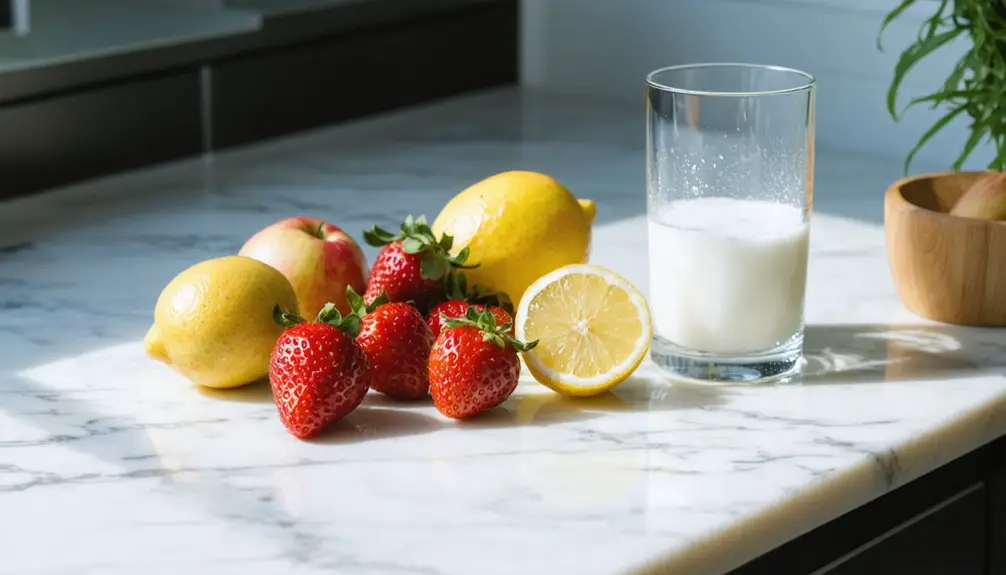You can naturally whiten your teeth using several proven alternatives to expensive treatments. Oil pulling with coconut or sesame oil helps remove bacteria, while baking soda‘s mild abrasive properties tackle surface stains. Crunchy fruits and vegetables like apples and carrots act as natural scrubbers, and foods rich in malic acid provide gentle whitening effects. Combine these methods with smart dietary choices and proper oral hygiene to discover your path to a brighter smile.
Key Takeaways
- Oil pulling with coconut or sesame oil for 10-20 minutes daily helps reduce bacteria and may gradually whiten teeth naturally.
- Mix baking soda with water to create a gentle, abrasive paste that removes surface stains when used 2-3 times weekly.
- Eat crunchy fruits and vegetables like apples and carrots, which naturally scrub teeth while stimulating helpful saliva production.
- Strawberries contain natural malic acid that gently whitens teeth when mashed and applied directly to tooth surfaces.
- Rinse with diluted 3% hydrogen peroxide for 1-2 minutes to safely lighten tooth color under professional guidance.
The Ancient Practice of Oil Pulling
While oil pulling has gained recent popularity as a natural teeth whitening method, this practice traces its roots to ancient Ayurvedic medicine in India, where practitioners have used various oils for oral health for thousands of years.
The traditional practice involves swishing oil in your mouth for 10-20 minutes before breakfast, typically using coconut, sesame, or sunflower oil. You should continue until the oil loses its viscosity. Some practitioners swear by its ability to pull out toxins from the body through the mouth.
While oil pulling benefits may include reduced bacterial counts in saliva, scientific evidence for teeth whitening remains limited. Studies show mixed results, with some reporting slight improvements in tooth lightness after prolonged use, while others find no significant whitening effects.
If you’d like to try this traditional practice, use a tablespoon of oil, swish for 10-15 minutes on an empty stomach, and always spit out the oil afterward to avoid swallowing bacteria.
Harnessing the Power of Baking Soda
Another time-tested natural whitening method comes from a common household ingredient: baking soda. This mild abrasive effectively removes surface stains from coffee and tobacco while balancing your mouth’s pH levels to fight decay and gum disease. Studies have shown that baking soda is gentle on tooth enamel.
While baking soda benefits include antibacterial properties and acid neutralization, its whitening effectiveness falls short of professional treatments. The method is highly affordable compared to costly dental whitening procedures. You’ll see better results using it as a complement to your regular oral care routine rather than a replacement.
For best results, limit applications to 2-3 times weekly, using gentle circular motions to protect your enamel.
Remember to avoid mixing baking soda with acidic ingredients like lemon juice, which can damage teeth. Instead, combine it with your fluoride toothpaste to maintain both whitening and cavity protection benefits.
Natural Whitening Foods in Your Kitchen

Your kitchen contains powerful natural teeth whiteners, including crunchy fruits and vegetables that mechanically remove stains while stimulating cleansing saliva production.
You’ll find that foods like apples, carrots, and celery act as natural tooth scrubbers, physically lifting away surface stains during chewing. Strawberries contain malic acid that naturally whitens teeth through gentle chemical action.
Calcium-rich dairy products such as cheese and yogurt strengthen your enamel while providing gentle whitening effects through their natural acids and minerals. Drinking milk helps prevent stains since its casein protein binds to teeth-discoloring compounds.
Crunchy Fruits Fight Stains
If you’re seeking natural ways to brighten your smile, crunchy fruits offer a scientifically-backed solution for combating tooth stains. The natural stain removal properties of apples, pears, and even vegetables like carrots work through multiple mechanisms to enhance your dental health.
These crunchy fruit benefits stem from their unique composition: high water content stimulates saliva production, while natural acids like malic acid help dissolve surface stains.
Their fibrous texture acts as a gentle abrasive, mechanically removing plaque and discoloration without damaging enamel. Studies show that regular consumption of these foods can reduce oral bacteria by up to 30%, diminishing stain-causing biofilm.
For best results, incorporate fresh apple slices or celery sticks after meals, always pairing them with water to maximize cleansing effects.
Calcium-Rich Foods Protect Enamel
While crunchy fruits actively combat surface stains, calcium-rich foods work at a deeper level to protect and strengthen your tooth enamel.
Getting adequate calcium is critical since deficiency causes your body to extract minerals from teeth and bones.
You’ll find excellent calcium sources in dairy products like cheese, milk, and yogurt, which help balance your mouth’s pH while fortifying enamel strength. Your dairy options are especially effective since they contain phosphates and casein that directly strengthen tooth structure. For dairy-free options, incorporate leafy greens, almonds, and sesame seeds into your diet.
Don’t overlook canned fish with edible bones, particularly salmon and sardines, which deliver both calcium and omega-3s for thorough oral health.
To maximize absorption, pair these foods with vitamin D sources and spread your calcium intake throughout the day.
Safe Ways to Use Hydrogen Peroxide
Using hydrogen peroxide safely for teeth whitening requires strict adherence to concentration guidelines and proper application methods.
You’ll want to stick with concentrations at or below 3% for at-home use to protect your enamel and gums from damage. For safe application, dilute the hydrogen peroxide with equal parts water, or create a gentle paste by mixing it with baking soda.
Never exceed recommended exposure times of 1-2 minutes per session, and limit whitening to twice weekly. The oxidizing action breaks down surface stains on your teeth to reveal a whiter smile. Professional supervision is recommended to ensure optimal results and prevent potential damage. You’ll need to monitor for sensitivity and gum irritation, discontinuing use if these occur.
Before starting any hydrogen peroxide whitening routine, consult your dentist to verify it’s appropriate for your dental health. Always choose ADA-approved products and avoid using hydrogen peroxide on damaged or sensitive teeth.
Daily Habits for Whiter Teeth

Maintaining whiter teeth requires a consistent daily routine of proven hygiene practices and preventive measures.
A bright, healthy smile depends on dedicated daily care and proven dental practices that protect and preserve natural tooth whiteness.
You’ll achieve superior results by combining proper brushing techniques with daily flossing benefits. Brush for two minutes twice daily using a soft-bristled toothbrush and fluoride toothpaste, ensuring you cover all tooth surfaces and your tongue.
Floss once daily to remove debris between teeth where discoloration often begins. Complement these practices by rinsing with antibacterial mouthwash and staying hydrated throughout the day.
Include crunchy fruits and vegetables in your diet, as they naturally scrub teeth while promoting saliva production. Swish with water after meals, especially following acidic or staining foods.
These habits work together to prevent plaque buildup, strengthen enamel, and maintain your teeth’s natural whiteness.
Smart Dietary Choices for Brighter Smiles
Your food choices play a vital role in maintaining naturally white teeth, with certain fruits, vegetables, and dairy products containing compounds that actively fight stains and protect enamel.
You’ll find powerful natural whitening agents in malic acid-rich foods like strawberries and apples, while crunchy vegetables stimulate saliva production to wash away stain-causing debris.
Natural Stain-Fighting Foods
Many everyday foods contain natural compounds that can help whiten teeth and prevent stains from forming.
You’ll find malic acid, a powerful whitening enzyme, in strawberries and apples. Applying strawberry paste directly to your teeth can provide gentle whitening effects, while the enzyme benefits extend to increased saliva production that naturally cleanses your mouth.
Crunchy fruits and vegetables act as natural toothbrushes. Apples, celery, and broccoli physically remove plaque while you chew.
Dairy products strengthen your enamel through calcium and lactic acid, while tropical fruits like pineapple and papaya contain enzymes that break down stain-causing proteins.
For additional cleaning action, incorporate nuts and seeds into your diet, as their textured surfaces help scrub away surface stains during consumption.
Prevent New Tooth Discoloration
While bright smiles depend heavily on proper dental hygiene, preventing new tooth discoloration starts with smart dietary choices. You’ll want to limit acidic and dark-pigmented condiments like soy sauce and balsamic vinegar, opting instead for lighter alternatives.
When you do consume staining foods, pair them with leafy greens for natural cleaning action.
Restrict your sugar intake to four or fewer times daily, and use a straw when drinking colored beverages to minimize enamel contact.
After consuming staining foods or drinks, rinse with water rather than brushing immediately – this protects your enamel while washing away pigments.
For additional enamel protection, stimulate saliva production by chewing sugar-free xylitol gum or enjoying non-cariogenic foods like hard cheese and nuts.
Strategic Eating Habits Matter
Strategic food choices play a pivotal role in maintaining naturally white teeth, especially through enzymatic and mechanical actions.
You’ll find that mindful eating of strawberries and pineapples helps dissolve surface stains through their natural enzymes, while crunchy produce like apples and celery acts as nature’s toothbrush.
Your strategic meal planning should incorporate dairy products, as they’re rich in enamel-strengthening minerals.
You’ll want to pair these with adequate water consumption throughout the day to rinse away potential stains.
When you’re drinking beverages that could stain, use a straw to minimize contact with your teeth.
For best results, structure your meals to end with foods that naturally cleanse, such as crunchy vegetables or cheese, which stimulate protective saliva production.
When to Consider Professional Help
Despite the availability of numerous over-the-counter whitening products, certain situations call for professional dental intervention to achieve ideal teeth whitening results.
You’ll want to seek professional evaluation if you’re experiencing persistent discoloration that hasn’t responded to at-home treatments, or if you have uneven tooth color following orthodontic work.
Professional intervention becomes especially important when you need rapid results for special occasions like weddings or reunions.
Safety considerations also dictate when to consult a dental professional. If you’re experiencing increased tooth sensitivity or gum irritation from whitening attempts, a dentist can adjust your treatment protocol and recommend appropriate protective products.
They’ll create a customized approach based on your specific staining, oral health status, and sensitivity levels, ensuring both effective and safe results that can last up to three years with proper maintenance.
Frequently Asked Questions
Can Pregnant Women Safely Use Natural Teeth Whitening Methods?
While 75% of pregnant women experience gum sensitivity, you can safely use gentle natural remedies like coconut oil pulling and turmeric. Focus on oral safety by avoiding harsh abrasives and consulting your dentist first.
How Long Does It Take to See Results From Natural Whitening Methods?
You’ll start seeing visible results from natural whitening methods within 7 days, with ideal brightness developing over 2-3 weeks. Your timeframe expectations should account for stain severity and treatment consistency.
Do Natural Whitening Methods Work on Artificial Teeth or Crowns?
Persistently trying to whiten artificial teeth naturally won’t work. Your crowns and restorations don’t respond to whitening methods because they lack natural enamel’s organic components that enable color changes.
Should Children Use Natural Teeth Whitening Techniques?
You shouldn’t use whitening techniques on children under 15 due to safety concerns. Focus on children’s dental health through proper brushing, healthy eating, and safe products approved by pediatric dentists.
Can Natural Whitening Methods Reverse Deep Internal Tooth Stains?
You can’t effectively reverse deep internal tooth stains with natural methods alone. These stains lie beneath your enamel, requiring professional internal whitening treatments to achieve meaningful results.
References
- https://www.healthline.com/nutrition/whiten-teeth-naturally
- https://pmc.ncbi.nlm.nih.gov/articles/PMC10024105/
- https://www.luriedental.com/dental-services/cosmetic/blog/do-natural-teeth-whitening-remedies-really-work
- https://www.medicalnewstoday.com/articles/322421
- https://newsnetwork.mayoclinic.org/discussion/mayo-clinic-q-and-a-many-safe-choices-available-to-help-whiten-teeth/
- https://azjd.researchcommons.org/cgi/viewcontent.cgi?article=1301&context=journal
- https://pmc.ncbi.nlm.nih.gov/articles/PMC9602184/
- https://pmc.ncbi.nlm.nih.gov/articles/PMC7475120/
- https://www.listerine.com/cavities-strong-teeth/oil-pulling-for-teeth
- https://www.nature.com/articles/sj.bdj.2018.281



